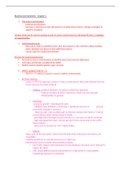Summary
Summary Business Studies Grade 12 IEB summaries of all chapters
- Course
- Institution
These notes cover all 9 chapters that need to be learnt for matric prelims and finals. I used these notes to study for my final IEB business studies exam and received an A+. They are colour-coded, organised and detailed. They have been checked by an IEB grade 12 matric business studies teacher. The...
[Show more]



